Canon VI-L, VI-T Rangefinder Cameras
A Description of these export models produced in 1958-1961
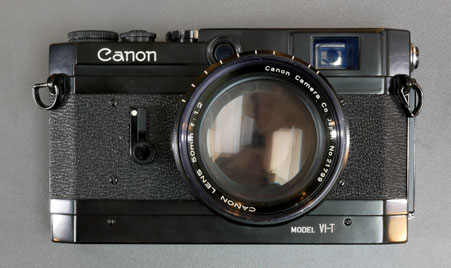
a black Canon VI-T with a less common black finished 50mm f1.2 lens
Introduction of the Canon VI-L, VI-T Rangefinder Cameras
With the success of the Nikon SP introduced in 1957 followed soon by the Nikon S3, Canon sought to show significant technical advances in its new offerings. The Canon VI-L and VI-T introduced in the summer of 1958 were its answer to this Nikon challenge.
Canon VI-L, VI-T Characteristics
The Canon VI-L and VI-T had a number of new attributes:
- a new shutter mechanism with a single, non-rotating shutter speed dial.
- with both flash bulb and electronic strobe flash synchronizatrion, a new higher X synchronization speed of 1/55 second was part of the new shutter mechanism.
- slots in the shutter speed dial allowed easy and direct linkage to a compact light meter accessory that could be slipped into the accessory shoe.
- an improved viewfinder with a larger eyepiece, still with the choice of a finder image with 50mm and 100mm projected, parallax-corrected frames and a second choice of a 35mm viewfinder image.
- the cameras were offered with a new Canon 50mm f1.2 lens; faster than the 50mm lenses offered by Leica or Nikon.
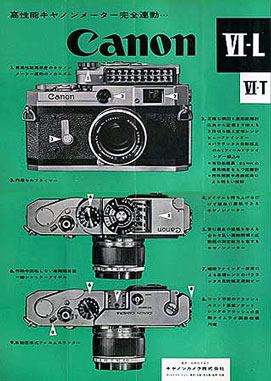
1958 Canon advertisement showing the Canon VI-L with accessory light meter
The Canon VI-L and VI-T Viewfinder
Contemporary Leica and Nikon rangefinders use projected viewfinder frames, while Canon used viewfinder frames that were reflected in the viewfinder structure. While this was satisfactory in the new camera, in the years since, the reflective surfaces in these viewfinders have aged, causing flare and diminished visibility of the frames for the various focal lengths. However, the Canon VI-L and VI-T still featured a parallax adjusting pin in the accessory shoe which moved the Canon accessory viewfinder - an advanced feature unique to Canon.

the parallax adjustment pin located in the accessory shoe which links to the matching pin in the bottom of the Canon accessory finder
This useful parallex correction pin feature had been introduced in the Canon VT.

two Canon adjustable finders: 28mm and 100mm showing pivoting base which slides into the accessory shoe,
with arrows pointing to parallax adjustment pins which link to the corresponding pin in the accessory shoe
The Canon VI-T
As described in previous pages of this canonrangefinder.org site, Canon had promoted the baseplate film winding method for several years. This was first offered as an accessory: the Canon Rapid Winder introduced in 1951.
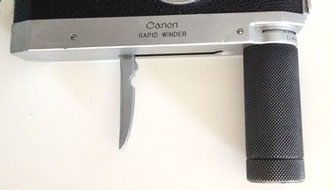
Canon Rapid Winder base introduced for its cameras in 1951
The Canon VI-L base also incorporated a large tripod socket at far end so that the accessory palm grip could be attached to make lever film wind easier.
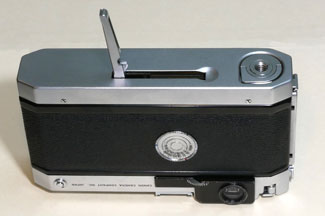
Canon VI-T base with winder
The Canon VI-L was Canon's final attempt to promote baseplate film winding to a wide base of photographers - ultimately unsuccessful. Active photographers showed by their purchases that the lever-style film winder was their preference. Perhaps Canon had realized this, because with the launch of the trigger winder VI-T, Canon also simultaneously launched the lever winder VI-L.
The Canon VI-L
Faced with the success of the Nikon SP introduced in 1957 and the Leica M-3 regularly upgraded during the 1950s, in the summer of 1958, Canon launched the Canon VI-L. identical to the VI-T, but with lever film advance.
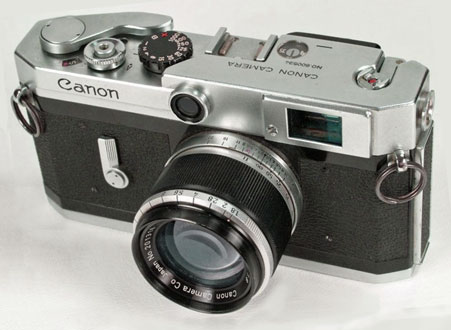
Canon VI-L with Canon 50mm f1.8 lens
This was an attractive new model, and the new shutter and non-rotating shutter speed dial, without a separate slow speed dial allowed the attachment of the compact light meter. (Leica had introduced a non-rotating dial with the M3 in 1954.) The light meter was slipped into the accessory shoe and a shutter speed dial of the meter clipped into the camera shutter speed dial, below. This provided an integrated f-stop measurement for any selected shutter speed.
Also, the Canon VI-L 35mm focal length viewfinder image was superior to that of the Nikon SP, and to the Leica M-3 which required an accessory finder for the increasingly popular 35mm wide-angle lens. Also, the 50mm viewfinder image was 1:1 which allowed the photographer to shoot with both eyes open, unlike either the Leica or the Nikon.
Flash photography was also improved. The X synchronization speed of 1/55 second eliminated the risk of 'ghost' images possible with the slow 1/15 second flash synchronization of earlier Canons. Also, no photographer switching between flash bulb synchronization and electronic strobe flash synchronization was necessary; this was done internally by the camera according to the lens speed dial setting.
Canon Film Magazine V
The Canon VI-T and VI-L had a base plate that allowed for the use of the Canon Film Magazine. The key to open the camera back could also open and close the Canon Film Magazine.

Canon VI-L base plate with back opening key on right
The Canon Film Magazine V was the latest of a series of Canon Film Magazines which allowed photographers to load 35mm film into a cartridge which did not have the standard Kodak felt light guards through which the film had to pass. Some photographers thought these Kodak 135 cartridge light guards could abrade the film surface, while the Canon Film Magazine did not touch the film surface.
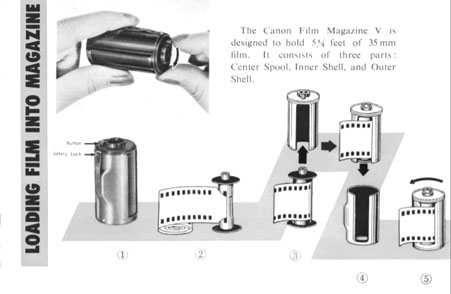
Canon Film Magazine V
The Canon Film Magazine V would allow the photographer in a darkroom to load about 160 cm or about 5 feet of 35mm film (36 exposures) into the Magazine which when closed was light-tight. The key on the Canon base plate would allow the Canon Film Magazine to open for photography, then rewind and close to remove the exposed film.
Sales of the Canon VI-T and of the Canon VI-L
The Canon VI-T with its new features sold moderately well during the two year period June 1958 to July 1960 selling 8,175. The lever wind Canon VI-L during three years June 1958 to March 1961 sold even more with 10,350 units sold. 1 Both sales were of respectable levels, but were far short of what might have been expected from what was a new generation of Canon rangefinder production. The sales of landmark Canon cameras such as the Canon IVSB of 35,000 over a similar time span as the Canon VI-L demonstrated what a good commercial result could be hoped for. The Nikon SP sold about 21,300 units over a three year period. 6 In fact it was the Canon P, also launched in 1958, which showed what commercial success could be achieved. The Canon P which Peter Dechert described as "a simplified VI-L" would sell 87,875 units during about the same period as the VI-L. 1
Nevertheless, the Canon VI-L when it was introduced was one of the most able and easy-to-use cameras for amateur or professional - that is before in later years the rangefinder became progressively more cloudy. The VI-L's difficulty was to be competing with the Nikon SP and the Leica M-3, both of which were launched earlier, and which had become the established choice of professional photographers.
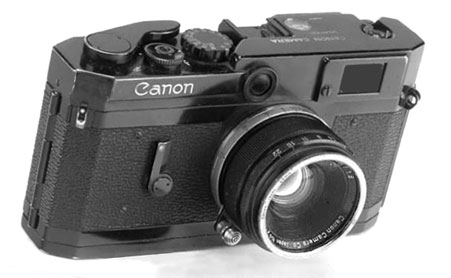
black Canon VI-L with Canon 50mm f1.8 lens
You can click on the links in the table below to consult other pages of the canonrangfinder.org site.
| Navigation: Click Below to Jump to Desired Subject Page | ||
|---|---|---|
| Canon Rangefinder Cameras - 1 | Canon Rangefinder Cameras - 2 | Canon Rangefinder Lenses |
| Canon S | Canon IVSB2 | Canon 19mm |
| Canon J | Canon IIS2, IID2, IIF2 | Canon 25mm |
| Canon NS | Canon VT, Canon L2 | Canon 28mm |
| Canon JS | Canon L1, L3 | Canon 35mm |
| Canon J-II | Canon VT Deluxe | Nikkor 50mm |
| Canon S-II | Canon VL, VL2 | Canon 50mm |
| Canon IIB | Canon VI-L, VI-T | Canon 85mm |
| Canon III, IIC, IV | Canon P | Canon 100mm |
| Canon IIIA, IVF, IVS | Canon 7 | Canon 135mm |
| Canon IIA, IID, IID1 | Canon 7s | Canon 200mm-1000mm |
| Canon IVSB | Minolta Rangefinders | Minolta Lenses |
| Canon IIF, IIS | Other Rangefinders | other M39 lenses |
| Go to canonrangefinder.com home page | ||
Any additions or corrections to these pages would be welcome simply by contacting this site as shown at the foot of this page .
Footnotes:
1 Dechert, Peter. Canon Rangefinder Cameras 1933-1968. Hove Collectors Books. West Sussex, United Kingdom. 1985. ISBN 0-906447-30-5.
Peter Dechert's book is the most important expert source of information regarding Canon Rangefinder Cameras.
2 Kitchingman, Peter. Canon M39 Rangefinder Lenses 1939-1971. A Collector's Guide. Published by Peter Kitchingman. Perth, Australia. 2008. ISBN 978-0-646-48144-9.
Peter Kitchingman's book is the definitive study of the more than three decades of M39 format camera lenses developed for Canon Rangefinder Cameras.
3 Nostalgic Canon Camera Book. 懐かしいキヤノン EI Publishing Co. Ltd. Tokyo, Japan. June 2003.
Peter Kitchingman's book is the definitive study of the more than three decades of M39 format camera lenses developed for Canon Rangefinder Cameras.
4 "Canon Camera Museum" history website. https://global.canon/en/c-museum/history/ published by Canon, Inc. accessed in 2019.
5 Rajner, Hans P. (author), John Wade (editor). Leica Copies. Classic Collections Publications. London, UK. ISBN 13: 9781874485056
Hans P. Rajner's book is an excellently detailed and carefully researched study of camera from around the world which used the Leica M39 lens mount and the same lens to film plane distance.
7 Dechert, Peter. Canon Single Lens Reflex Cameras 1959-1991. Historical Camera Publications. Yakima, Washington. 1992. ISBN 1-879561-04-2.
8 Tomlinson, Shawn M. The Film Photography Book. Lulu Pulbications. 2016. ISBN: 9781365263972
9 Sartorius., Ghester. Identifying Leica Lenses. Classic Camera 19. Tokyo, Japan. 2001. ISBN 4-257-12029-0
10 website http://www.nicovandijk.net/rflensmatrix.htm consulted 2019.
11 O'Reagan, Douglas M. Allied Exploitation of German Science after World War II. Johns Hopkins University Press. Baltimore, Maryland. 2019. ISBN 9781421428888
12 website www.canonrangefinder.servehttp.com consulted 2008.
13 Minolta expert Andrea Aprà has posted information on minoltarangefinders group and other groups and further detailed information by email. (thanks Andrea !)
14 website http://www.collection-appareils.fr/objectifs/ consulted 2019.
15 Small, Marc James. Non-Leitz Leica Thread-Mount Lenses. Wittig Books. Hückelhoven, Germany. 1997. ISBN 3-930359-47-2.
16 the Nikon Corporation website: https://imaging.nikon.com/history/ consulted 2019.
17 p 152. Ray, Sidney F. Photographic Lens ISBN 9780240510323
18 website http://www.rokkorfiles.com/Lens%20History.html accessed 2019
19 Katz, Jerome. The Kardon camera story: a dedication to Peter Kardon, great American patriot & pioneer. SJF Enterprises. New York, New York. 1977.
20 Baird, John. The Japaneese Camera. The History of the Japanese Camera Monograph Collection. Historical Camera Publications. Yakima, Washington. 1990. ISBN 1-879561-02-6.
21 interesting website http://www.topgabacho.jp/Topconclub/Leotax.htm accessed 2019
If you have any comments or questions about this Canon Rangefinder site, please e-mail me (Larry Huffman) at e-mail address: [email protected]